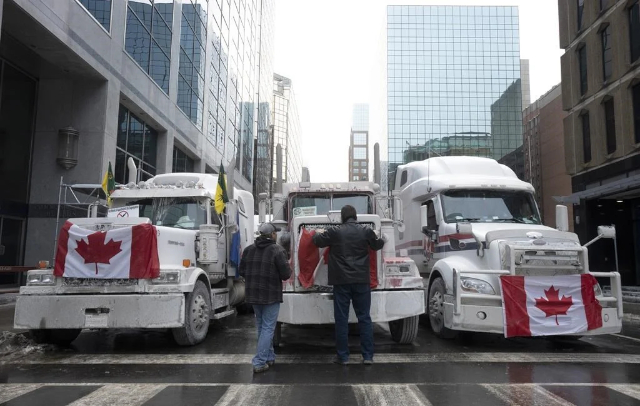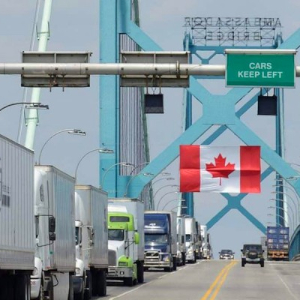We’ve been plagued lately with doomsday predictions of food shortages across North America because of the lack of transport truck drivers and, more recently, the big protests by truckers over mandatory COVID vaccinations if they want to cross the Canadian Border…
 Angry truckers blocked all the downtown Ottawa streets leading to Parliament Hill on
Angry truckers blocked all the downtown Ottawa streets leading to Parliament Hill on
February 2, 2022, protesting the vaccine mandate for drivers entering Canada.
When you look at the pictures of giant transport trucks blocking the downtown streets of Ottawa and other cities protesting the Canadian government vaccine mandate, it’s easy to imagine that a food shortage might be in the offing. Essentially, truckers – not all American – are up in arms over the mandate because it would require them to quarantine for a couple of weeks if they can’t provide proof of vaccination when crossing the border into Canada (see photo, top of page).
I know. It’s crazy sounding. A truckful of lettuce would be fit only for the landfill after waiting that long at the border. Same goes for almost any item of produce you choose to name. But the idea is, the Canadian government wants to protect Canadians. And it’s using the threat of quarantine to try to lever drivers to get vaccinated. Trouble is, many transport drivers are owner-operators who get loads from brokers. They don’t have to follow any company vaccine mandate to qualify to work.
Back in the deepest depths of the COVID pandemic, when worker shortages and mandatory closures were at their worst, we found ourselves in a similar situation. Now, the same conditions prevail, just for slightly different reasons.
A perfect storm?
A whole complex of things is making it hard for food processors to keep up with demand. Some observers are even calling it a ‘perfect storm’. Once again, high employee absenteeism is a real problem – up to 20 per cent in some plants, Michael Graydon, CEO of Food, Health & Consumer Products of Canada, told The Canadian Press. Supply line issues are causing fluctuating shortages of ingredients and packaging materials, which are temporarily shutting down some production lines.
According to Graydon, the situation has prompted some food suppliers to inform grocers about the steps they’re taking to fulfill orders, including finding new sources for materials, adding transportation capacity and even changing product formulations in some cases. Transportation costs have also increased dramatically, as customers are competing for the services of the drivers who are working.
What’s going on at our end?
As a result of all the upheaval behind the scenes, some of the brands, sizes or flavours of some products consumers are looking for may be temporarily out of stock. Or, more likely, the choice available across product ranges may be curtailed. For example, at least one pasta maker has shut down production of all but it’s top-selling varieties. You might be able to get only one size of your fave mayonnaise for a while. Or have to switch to another brand temporarily.
The bottom line
“There are certain commodities that will come and go and be a bit sporadic,” Graydon said. “But the essentials [of] life will there.”
Translation: “You’ll notice temporary shortages of certain commodities, but no one’s going to have to miss any meals, much less come anywhere close to starving.”
Meanwhile, food prices are edging up toward the all-time highs of 2011, Bloomberg Business News reports. The effect is dampened in North America where we produce our own domestic supplies of the basic food staples. But we’ve been warned that we’re not immune. And food prices are currently pushing previous records. Most economists agree that we won’t see any food price relief until this summer or early fall – if we see any at all.
And that’s a more serious situation for us all, as consumers, than temporary shortages of jumbo jars of Crunchy Peanut Butter…
~ Maggie J.

